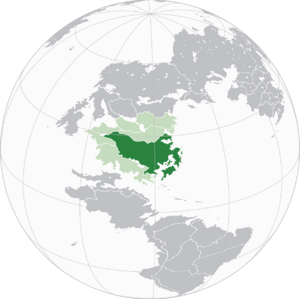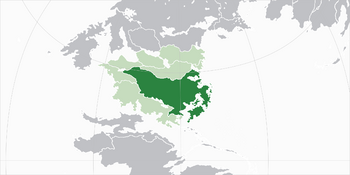Federated Fire Territories: Difference between revisions
Deskjetser (talk | contribs) mNo edit summary |
Deskjetser (talk | contribs) mNo edit summary |
||
| Line 83: | Line 83: | ||
Although Anglicised as ''federal'', the Fyrish/Old-Anglian root stems from ''ferlaecan'' (fērlæcan), meaning unity through association. This term arose during the 1203 Acts of Association, whereby an association of Fire Shires became legally defined as: ''"an association of shires and peoples through which we are united"''. The first official use of ''Fire Territories'' (Fȳrēþel — literally: Fire-Territory) dates from the 16th century. The collapsing Niranic empire opened a void in regional politics by 1545, leading to the cementation of existing shires under the sovereign and the foundation of new states separate from Byzran. | Although Anglicised as ''federal'', the Fyrish/Old-Anglian root stems from ''ferlaecan'' (fērlæcan), meaning unity through association. This term arose during the 1203 Acts of Association, whereby an association of Fire Shires became legally defined as: ''"an association of shires and peoples through which we are united"''. The first official use of ''Fire Territories'' (Fȳrēþel — literally: Fire-Territory) dates from the 16th century. The collapsing Niranic empire opened a void in regional politics by 1545, leading to the cementation of existing shires under the sovereign and the foundation of new states separate from Byzran. | ||
The noun ''Fyrish'' refers to the people of the Fire Territories or the language, also called Old-Anglian, ''whilst'' the adjective Fyrish denotes a relation to the Fire Territories. ''Fyrfolk'' refers to a broad group of ethnicities that | The noun ''Fyrish'' refers to the people of the Fire Territories or the language, also called Old-Anglian, ''whilst'' the adjective Fyrish denotes a relation to the Fire Territories. ''Fyrfolk'' refers to a broad group of ethnicities that comprise the Fire Territories' modern populous. | ||
===In other languages=== | ===In other languages=== | ||
{| class="wikitable" | {| class="wikitable" | ||
Revision as of 00:39, 26 April 2023
Federated Fire Territories Fērlæcende Fȳrēþel | |
|---|---|
|
Flag | |
Motto: “Eftārīsan fram þās ahse.” "Rise again from these ashes." | |
Fyrland & Lower Vinya | |
| Capital | Heafodstol |
| Largest city | Brecanburg |
| Official languages | Fyrish; Isaetinyan |
| Recognised regional languages | Iweric |
| Demonym(s) | Fyrish |
| Government | Federal Constitutional Monarchy |
• Monarch | Æþelric XIII |
| Establishment | |
• Acts of Association (Fyrish: Forma Dōþ of Annes) | 1203 |
• Second Acts of Association (Fyrish: Ōðer Dōþ of Annes) | 1487 |
| Area | |
• Total | 4,269,490 km2 (1,648,460 sq mi) |
| Population | |
• 2018 census | 315,210,000 |
• Density | 73.83/km2 (191.2/sq mi) |
| GDP (PPP) | 2018 estimate |
• Total | $12,357.48 billion |
• Per capita | $39,204 |
| GDP (nominal) | 2018 estimate |
• Total | $8,522.4 billion |
• Per capita | $27,037 |
| HDI (2018) | 0.842 very high |
| Currency | Fȳrpund (FTP; Ꞩ) |
| Date format | dd/mm/yyyy |
| Driving side | right |
| Internet TLD | .fyr |
The Federated Fire Territories, officially the Federated Fire Territories of Lower-Vinya and Overseas Territories (Fyrish: Fērlæcende Fȳrēþel of Erecg-Wīnya ac Ofersǣþel) but more commonly known as Fyrland or the Fire Territories, is a sovereign nation on the subcontinent of Lower Vinya. It comprises 24 states, known locally as shires, and several overseas territories. It shares northern borders with Livonia, Lom, Croga, Aill, and Ariana. To the west, the Fire Territories borders Shirvan and Tiri-Era, while it shares its most extensive border with Byzran to the south. The Fire Territories' expansive coastline to the east sits upon the North Meridian Ocean, commonly called the Crimson Sea, the nation's only ocean coastline. The total landmass of the Fire Territories is 4,269,490 square kilometres (1,648,459 sq miles), with an estimated 2018 population of 315 million. The Fire Territories' capital is Heafodstol (Fyrish: Hēafodstōl), and its largest city is Brecanburg (Fyrish: Brēcænburg), a global city and industrial centre. The greater Brecanburg area is one of the most populous metropolitan areas in the world. Other major urban centres include Faesteah, Clorethsted, Adlertun, and Hatathurg.
The composition and size of the Fire Territories have shifted throughout the past several hundred years. Following the Thrall Rebellion, the 1783 Thrall Reform Acts resulted in the consolidation of the union. It marked the end of the era of the states' rule over the historically feeble central government and the beginning of the modern Fyrish state. Norsatir seceded during the Thrall Rebellion before the conclusion of hostilities, leaving the Fire Territories as a handful of connected coastal states entering the 19th century. In the early 19th century, the Fire Territories began expanding westward across Lower Vinya, known as the Second Interior Wars — the westward expansion ended by 1860, incorporating several newly founded states. By 1891 the Fire Territories comprised 22 states and stretched from the Crimson Sea to the Eran mountains. The union briefly grew to include the provisional governments of Byzran and Eagla after the War of Senese Succession. Following Eaglan independence and the conclusion of the Vinyan War in 1980, Middle-Eagla acceded to the union. Most recently incorporated into the union is the state of Dabomasero, which seceded from Byzran in 2011 and acceded in 2013.
The Fire Territories government is a federal parliamentary system with three distinct elements: the bicameral House of Peers, the Committee of Crown Privy Councillors, and the Committee of Crown Trusted Advisors. The government derives its powers under the sovereign, a constitutional monarch. The current monarch is Athelric (Fyrish: Æþelric), who has reigned since 2005. As a representative democracy with representation for each state, many policy areas are devolved to the unicameral state legislatures known as Realm Councils. The Fire Territories ranks highly in quality of life. Despite lower immigration per capita, the Fire Territories has the world's largest immigrant population, estimated at 21 million. The Fire Territories has become a melting pot of cultures due to its close demographic ties with Anglia, Byzran, the Ivernic states, and Abyaalan migration. It has high levels of incarceration and inequality.
The Fire Territories is a developed country with the world's second-largest economy by nominal and purchasing power parity measures and the largest free market economy, accounting for approximately 10% of global GDP. By value, the Fire Territories is the world's largest importer and ranks highly in economic competitiveness, innovation, and education. As a founding member of the Septentrion League and a leading economic and military power, the Fire Territories is a powerful political, cultural, and scientific force within the international community.
Etymology
The name Fyrland originates from a 9th-century colloquialism relating to early farming settlements along the volcanically enriched Asceraes (Asceræs) valley. Despite volcanic activity and even historical volcanic eruptions, such as the 703AD eruption of Godstān, scholars believe Fyrland originates from Furhland, which means furrowed land. Fȳr-ian, meaning to make a fire, is vocally similar to fyr-ian and fuhr — to make a furrow and furrow, respectively — leading to Furhland coexisting with the name Fyrland. Contemporary historians think the visually impactful but low-level regional volcanic activity, like the Eternal Flames (Ēcefȳr), led to the supersession of Furhland with Fyrland, the latter appearing in official documents by the 11th century.
Although Anglicised as federal, the Fyrish/Old-Anglian root stems from ferlaecan (fērlæcan), meaning unity through association. This term arose during the 1203 Acts of Association, whereby an association of Fire Shires became legally defined as: "an association of shires and peoples through which we are united". The first official use of Fire Territories (Fȳrēþel — literally: Fire-Territory) dates from the 16th century. The collapsing Niranic empire opened a void in regional politics by 1545, leading to the cementation of existing shires under the sovereign and the foundation of new states separate from Byzran.
The noun Fyrish refers to the people of the Fire Territories or the language, also called Old-Anglian, whilst the adjective Fyrish denotes a relation to the Fire Territories. Fyrfolk refers to a broad group of ethnicities that comprise the Fire Territories' modern populous.
In other languages
| Anglian | Dayashinese | Gothic | Iweric | Jedorian | Menghean | Sebrenskiyan | Senese | Shinasthana | |
|---|---|---|---|---|---|---|---|---|---|
| Native | Fire Territories | フィレァンヅ | Tierra del Fuego | Tír na Tine | Gaisro žemė | 희르란드 | Požariya | Territori del Fuoco | 飛延 |
| Anglicised | Fireandzu | Hyirŭrandŭ | Pjur-lan |
History
First settlements
The settlement of anatomically modern humans in Lower Vinya (Erecg-Wīnya) occurred in waves, beginning with the end of the last glacial period c. 11,700 years ago. The earliest evidence of human activity within present-day Fyrland, on the Iwernricu peninsular, dates from 8000 BCE, with coastal settlements permeating the region.
Niranic Empire
By the end of the prehistoric period, the population of Lower Vinya principally consisted of Insular Niranic cultures comprising Byzrani, Pemimi, but also Ivernic peoples. The Niranic conquest began in 205 BCE, reaching its peak in the 11th century, encompassing much of Lower Vinya. The arrival of Ostlandic-Anglian settlers, called Walfolk (Fēþfolc), in 717 brought Old-Anglian to the continent. However, the Niranic empire initially ensured minimal settlement permeation inland by Walfolk. Through the expansion of the Niranic empire and the arrival of the Walfolk in Lower Vinya, the various cultures in the region interacted under the Niranic system of governance. The Walfolk found a place amidst the empire, becoming well-known and locally appreciated traders who often walked vast distances across Lower Vinya.


